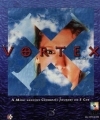The Vortex: Quantum Gate II
First posted on 26 April 1996. Last updated on 07 August 2009.

|
| The stroll through the Temple Bell is just one among the many breathtaking sceneries! |

|
| Quantum Gate is where the nightmare begins! |

|
| Are these Aylinde people good or evil? |
The original Quantum Gate: The Saga Begins... is based on an unique design concept called VirtualCinema pioneered by HyperBole Studios. VirtualCinema takes full advantage of the multimedia capability of the computer to provide a platform for interactive storytelling. Like its predecessor, The Vortex: Quantum Gate II bills itself not as an adventure game but as an interactive movie experience. Despite substantial improvements in the quality of both storytelling and production, this interactive game will still leave the player puzzled as to why such a sequel is made in the first place.
In this game, you assume the role of Drew Griffin, a young soldier recruited to fight a war against an anthropomorphic alien race on a distant world. The year is 2057. Due to severe environmental pollution, Earth has only five years to live. Only a rare mineral exists on the planet AJ3905 can reverse this environmental Armageddon. At the end of the original Quantum Gate, you and your comrades are transported through an interplanetary device called the Quantum Gate to destroy the alien inhabitants in order to excavate the needed minerals. Through your Virtual Reality tophat display, they appear in the form of alien bugs. When your tophat suddenly malfunctions, however, you discover that you have been tricked by your commanding officer Colonel Saunders to destroy a seemingly peaceful race known as the Aylinde instead.
Initially, you accept with reluctance help from the Aylinde people who have saved your life. While recovering from your injury, you explore their culture and philosophy of life. The familiar faces of these tribes people liken to the faces back on Earth trigger many emotional flashbacks of Drew's life back home. Although you may have uncovered the evil scheme of Earth's Eden Initiative, you also realize the Aylinde people have their own hidden agenda against humankind. Your trust is finally put to the test when you must choose which side to help. Even when you think you have made the correct choice, you soon realize life as you know it may just be a horrible nightmare (or fantasy) from which you should have never awaken in the first place.
HyperBole Studios has taken an unique direction in marketing this title. Rather than boasting its original puzzles, this game simply bills itself as "VirtualCinema" that emphasizes instead its interactive storytelling. VirtualCinema is a high-performance software engine used to create a "storyworld". It is designed specifically to play digital video and multimedia from a CD-ROM, taking full advantage of the multimedia PC platform. The CD ensemble allows for an attractive set of video collages to play to convey the story. An unprecedented six hours of digital video is backed by a Hollywood quality production, with over 30 professional actors forming the cast. Original digital and MIDI soundtracks have also been recorded by D'Cuckoo and composed by Candice Pacheco. The original soundtrack for the game is available on both compact disc and cassette from RGB Records.
Many hardware tools are used by HyperBole Studios to make this game. They include Silicon Graphics Indy, Silicon Graphics Indigo Extreme, Silicon Graphics Indigo, 24 various Apple Macintosh and Power Macintosh computers, 18 Pentium based PCs, Radius VideoVision Studio motion JPEG boards, Betacam SP recorder, Sony digital video cameras, 24-track digital audio sound equipment, and Pro Tools portable DAT sound equipment. The software tools used to make this game include Adobe After Effects, Adobe Photoshop, Adobe Premiere, SOFTIMAGE, Xaos Tools Pandemonium, and a variety of plug-in filters. According to the developer, ninety percent of the work is done using Adobe Premiere for Power Macintosh. It is used for the video manipulation work, including basic editing, performing color correction and audio synchronization, keying of actors into backgrounds, and integrating multiple layers of 2D and 3D graphics with video effects. The 2D images are manipulated and edited using Photoshop. Adobe After Effects is used for sophisticated special effects work, such as tracking actors' motions to enable the addition of computer generated wings by special effects artists. A battle sequence in which a native village is destroyed near the end of The Vortex illustrates the incredible power of Adobe Premiere. While the sequence looks like it is created entirely in a 3D environment, it is actually built from simple 2D and 3D elements, such as the 2D flame effects and the 3D village's hut and futuristic aircraft known as skivvers. These elements are composed and animated using Adobe Premiere software's motion control feature.
Videos are encoded in both Apple QuickTime for Windows and Microsoft Video for Windows formats. The game works best on a Multimedia PC Level 2 system. All movie files are compressed using the SuperMac Compact Video compressor that comes with the QuickTime for Windows developers kit. All sound effects are uncompressed wave files. Most graphics, or bitmaps, are stored in a propriety compressed bitmap file format. However, Microsoft's Video for Windows developer's kit includes a sample application, ICMAPP, that allows opening, viewing, compressing and decompressing this propriety format. The bitmaps are compressed using the MS Video 1 compression algorithm that was jointly developed by Media Vision and Microsoft. MIDI files are authored using only ten channels. Channels 1 to 10 contain all note information; no notes are heard on Channels 13 to 16.
The Vortex: Quantum Gate II is played entirely from a first person perspective. Various icons appear intermittently during playback of Full Motion Videos that convey the story throughout the game. By clicking on these icons, it allows the player to make inquires, guide Drew's actions, or display emotions. The emotion can be anger, balance, or sorrow. Some icons trigger supplemental videos to simulate various moments of flashbacks by Drew. Responses differ depending on the player's choices. A cursor is used to help the player to navigate through space by showing the available choices of directions. The game is played out in chapters, with a short epilogue preceding each chapter. There are multiple pathways in this game and nearly a dozen endings, though most endings are no more than quick death scenes.
The story of The Vortex: Quantum Gate II is written by Greg Roach who is also the writer of the first game in the series. Roach has been credited in creating the first interactive multimedia novel, The Madness of Roland, in the early 1990s which has earned Roach the moniker, "the Steven Spielberg of interactivity". This unique use of icons to trigger various interactive elements has subsequently been adopted by other adventure game titles. There can be no compliant to the cinematic quality of the animations. They are simply breathtaking to look at. Photorealistic 16-bit graphics provide an immersing environment that can be explored in detail. The acting in the game is very professional. The story is engaging and has an unexpected ending. Both highbrow and lowbrow humors are used. For example, when Drew makes a fatal choice, the game cuts away to a shot of the production staffs arguing with each other on how stupid this particular ending has been, or even funnier, to a shot with the player being disguised in front of his computer for losing the game so early. Even the winning end sequences are played along in similar lines. These multiple endings offer some replay value, since the entire collection of videos that cannot be viewed from only a single play of the game.
On the other hand, exactly what prompted HyperBole Studios to make this sequel has certainly eluded me. Its poor sale is a clear reflection of the fact that adventure gamers really hunger for good brainteasers and not just eye candy. There is not a single puzzle in this game! The sole object of this interactive title is to click on the screen to see the next movie clip. At times, there are just too many icons for the player to click. In order to view all the clips, the player must play the game over many times. Most players will not have the patience to sit through the many repetitive segments just to watch a few new segments. Most videos are played in small screens and are quite pixelated. Lip synchronization is also a problem at times.
Care must be taken when installing this game in Windows 95. The game automatically overwrites key drivers and files in order to install its own version of QuickTime in the \Windows\System directory, even if a later version has already been installed. This can cause the dreaded missing or conflicting .dll dynamic link library error. This error can also occur when installed in Windows 3.x if there is already a version of QuickTime installed prior.
Even with the breathtaking graphics and a decent story, this VirtualCinema title amounts to nothing more than eye candy with minimal interactivity, similar to its predecessor. Certain plot twists may be difficult to grasp without first playing the original Quantum Gate. Unlike the original game, there is currently no novel adaptation of this sequel. The excessive use of foul languages in the game is unnecessary, and the humorous twists at the end of the game may not find its audience. In the end, The Vortex: Quantum Gate II is simply an uninspired sequel in a forgettable adventure game series.

